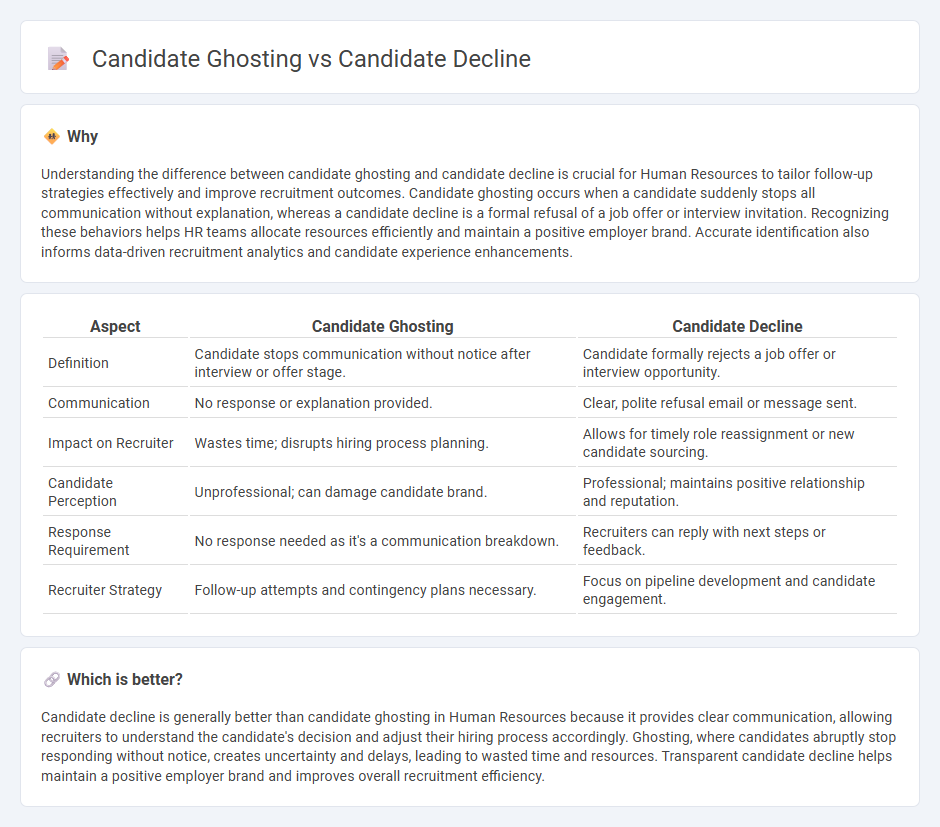
Candidate ghosting occurs when job applicants suddenly stop responding during the recruitment process, leaving employers without closure or feedback. Candidate decline happens when applicants explicitly refuse job offers, providing clear communication but potentially signaling misalignment in expectations or fit. Explore strategies to manage candidate ghosting and declines effectively to optimize hiring outcomes.
Why it is important
Understanding the difference between candidate ghosting and candidate decline is crucial for Human Resources to tailor follow-up strategies effectively and improve recruitment outcomes. Candidate ghosting occurs when a candidate suddenly stops all communication without explanation, whereas a candidate decline is a formal refusal of a job offer or interview invitation. Recognizing these behaviors helps HR teams allocate resources efficiently and maintain a positive employer brand. Accurate identification also informs data-driven recruitment analytics and candidate experience enhancements.
Comparison Table
| Aspect | Candidate Ghosting | Candidate Decline |
|---|---|---|
| Definition | Candidate stops communication without notice after interview or offer stage. | Candidate formally rejects a job offer or interview opportunity. |
| Communication | No response or explanation provided. | Clear, polite refusal email or message sent. |
| Impact on Recruiter | Wastes time; disrupts hiring process planning. | Allows for timely role reassignment or new candidate sourcing. |
| Candidate Perception | Unprofessional; can damage candidate brand. | Professional; maintains positive relationship and reputation. |
| Response Requirement | No response needed as it's a communication breakdown. | Recruiters can reply with next steps or feedback. |
| Recruiter Strategy | Follow-up attempts and contingency plans necessary. | Focus on pipeline development and candidate engagement. |
Which is better?
Candidate decline is generally better than candidate ghosting in Human Resources because it provides clear communication, allowing recruiters to understand the candidate's decision and adjust their hiring process accordingly. Ghosting, where candidates abruptly stop responding without notice, creates uncertainty and delays, leading to wasted time and resources. Transparent candidate decline helps maintain a positive employer brand and improves overall recruitment efficiency.
Connection
Candidate ghosting and candidate decline both negatively impact recruitment efficiency by reducing the pool of available talent and increasing hiring timelines. Ghosting occurs when candidates suddenly stop responding during the hiring process, while candidate decline refers to candidates explicitly rejecting job offers or interview requests. Both phenomena highlight the importance of effective communication and candidate experience management in human resources strategies.
Key Terms
Communication
Candidate decline occurs when a job seeker explicitly informs the employer about their decision to reject an offer, ensuring clear and respectful communication. Candidate ghosting happens when the candidate abruptly stops all communication without any notification, leading to uncertainty and disruption in the hiring process. Explore effective communication strategies to manage both scenarios and improve recruitment outcomes.
Feedback
Candidate decline involves a professional notification where the candidate provides feedback explaining their decision to withdraw from the hiring process, often offering valuable insights on the recruitment experience. Candidate ghosting occurs when the candidate abruptly ceases communication without any feedback or explanation, leaving employers uncertain about the reasons behind the lost opportunity. Explore effective strategies for obtaining constructive candidate feedback and minimizing ghosting impacts in your recruitment processes.
Engagement
Candidate decline represents a formal rejection where candidates inform employers about their decision not to proceed, preserving professional engagement. Candidate ghosting occurs when candidates abruptly cease communication, negatively impacting employer recruitment efforts and reducing engagement metrics. Explore effective strategies to improve candidate engagement and minimize both decline and ghosting scenarios.
Source and External Links
How to Reject a Job Applicant Politely? - This article provides tips on how to politely reject job applicants by showing gratitude, offering supportive guidance, and maintaining a positive tone to build positive relationships with rejected candidates.
How To Reject Candidates Politely and Without Burning Bridges - It offers guidance on writing a rejection email that is respectful and appreciative, while also being clear and direct about the decision.
What to Do When A Candidate Declines a Job Offer -- After Accepting - This article discusses how to handle candidates who decline job offers after initially accepting them, emphasizing the importance of maintaining a positive tone and leaving the door open for future opportunities.
 dowidth.com
dowidth.com